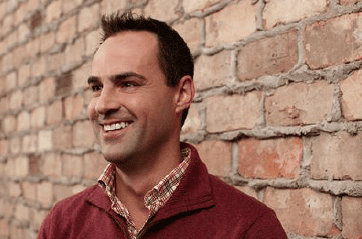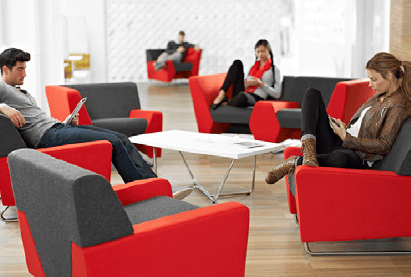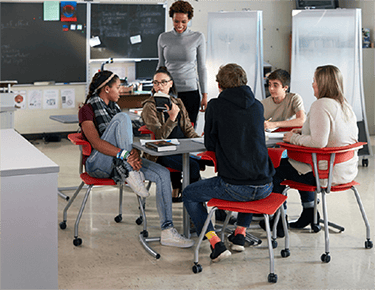Product Strategy Driven by User Observation at KI

By Bob Beck
No matter what industry it's in, product development strategy is central to a company's business strategy - workplace furniture and furnishings included. Customers are intrigued by and looking for innovation, and it's up to the product development team to deliver it. The question is how to go about it.
One way to decide what products to develop is to ask the sales team what additional products they need in order to grow. But there's a problem with that: it's very hard for people on the front line in sales - immersed in their own current products as they must be to succeed - to see beyond, “We need exactly what we've got only 15% cheaper.”
This is not the path to innovation.
Another common approach is to task the marketing department to come up with design briefs. Marketing teams will generally do a more thorough job of surveying what's available on the market in the company's relevant product categories and where the company has holes in its product offering. Briefs from marketing teams often sound something like, “We need an ergonomic work/task chair for launch at NeoCon 2018 with the following attributes (list of attributes) that we can sell for $x,xxx and that will compete with the following products (pictures of target competitive products with their price ranges).
This is a clear definition of what already exists, and in the hands of the right designer it leads to innovation. But it's not a sure thing and will mostly likely lead to “innovation” of the small kind - 3” casters rather than the usual 2.25”.
I shouldn't leave out the very successful strategy of shopping the global furniture markets for innovative products foreign companies have already developed. In this case the level of innovation brought to market here in North America relies on the talent of the company representatives charged with finding it; talent to recognize the level of innovation as well as talent to negotiate a deal that can overcome the many hurdles and pitfalls to making such a deal work for both parties. The “talent” to successfully implement this type of strategy usually requires that the traveling team has also done a lot of the marketing research referred to above.
There is a product development strategy that is newer than the two first mentioned above, i.e. asking sales or relying solely on marketing. It's how companies like IDEO, working across many industries developing products for vastly different client companies, do it. This more enlightened approach incorporates all the standard market research referred to above, but it adds extensive user observation and discussion with users about how they work and why they do it that way. But rather than asking people via questionnaires this is a more passive, observational way of gaining understanding. When done well, it can really stimulate new ideas as to how the task at hand might be made easier or better with a new solution.
Giving designers the time and opportunity to meet with potential users of the new product lets those designers get truly creative and leads to innovation much more certainly than any design process omitting this important step. This is the strategy that has led KI to the development of a significant body of innovative work over the last several years.
 When Shawn Green, Vice President of Design and Product Marketing, arrived at KI about 10 years ago, he found it was still relying on marketing briefs with input from the sales force for new product ideation. Being a believer in the user observation strategy, he started introducing that method to the process. I recently asked him to describe how KI's application of the user observation approach has informed its seating launches over his tenure.
When Shawn Green, Vice President of Design and Product Marketing, arrived at KI about 10 years ago, he found it was still relying on marketing briefs with input from the sales force for new product ideation. Being a believer in the user observation strategy, he started introducing that method to the process. I recently asked him to describe how KI's application of the user observation approach has informed its seating launches over his tenure.
Shawn Green:
“About five years ago we were observing students sitting in classrooms, and what was crystal clear is that none of them were sitting the way the ergonomic seating charts say they're supposed to. We saw students sitting with their legs crossed, sitting on one foot, slouching - you name it. So we came up with the idea of adaptive seating. For us that meant we weren't going to be prescriptive about the way people sit, but we'd design our products to allow for a wide range of non-standard, unorthodox seating styles.”
“The first product we designed incorporating the adaptive seating idea was the Sela lounge. Launched in 2012, Sela is intended for reception and lounge areas in higher ed., healthcare and corporate applications. We gave it an oversized scale with an increased degree of recline to accommodate many different postures and maintain a very high degree of comfort. We also took into account the needs of users other than those sitting in Sela, offering a sled base that's highly mobile by sliding easily over virtually any surface.

“Then In 2014, we introduced My Way Lounge Seating, incorporating our adaptive seating model. For My Way we performed extensive user observations, mostly in higher ed. settings, and we learned a lot. Starting with an armless version that is essentially just a comfortable seating platform, we gave My Way a variety of arms with unique asymmetrical forms that are very receptive to unorthodox seating styles. Then, based on how we saw students using lounge seating we added a work arm that's useful for laptops, mobile devices and even old-fashioned writing.”
“In many ways the design of the Sway Lounge epitomizes KI's philosophy of adaptive seating, and if winning Contract magazine's Best of NeoCon Innovation Award says anything about innovation, it proves my point about the value of user observation as a path to innovation. By the time the product development team started work on what was to become Sway, user observation was a well-established part of the process. With its 360 degree movement, users can sit back and relax or lean in to discuss or focus.
“In order to achieve the movement the team wanted, it also had to innovate in the selection of materials and production processes, leading to an innovation award from the Association of Rotational Molders. My point is that innovation in one area of a design very often leads to innovation in other aspects, such as material selection or manufacturing process.
 The Ruckus Chair, recently launched at EdSpaces 2017, is KI's latest embodiment of the adaptive seating philosophy. Once again, the shape of the chair is driven by the design team's observations of students in classrooms.
The Ruckus Chair, recently launched at EdSpaces 2017, is KI's latest embodiment of the adaptive seating philosophy. Once again, the shape of the chair is driven by the design team's observations of students in classrooms.
“We noticed that teachers tend to be very migratory in their teaching styles,” said Mr. Green. “The kids are working in small groups and teachers are moving around the classroom; the classrooms themselves tend to be less orthogonal in layout. So it can be difficult for students to follow the teacher's movements and keep a line of sight, which is important for keeping the level of engagement high.”
“We designed Ruckus so that people sitting in it could pivot easily to maintain eye contact with the instructors without being disruptive. The seat is unusual because its “front” is turned down to allow sitting in all directions - in other words there is no front of the chair per se. We also designed a unique backrest that can double as an armrest or small tablet arm and allows many different seating positions, including using it as a perch.”
Close observation of the ways people are going about using products in their day-to-day activities can inform design and stimulate innovation. To make that point in this article, I've cited KI's ongoing seating development. But the technique is used throughout KI's product development process, whether dealing with a system product, demountable walls, storage or patient room furniture. Observing users in action is not a guarantee of innovation, but it increases the odds by a significant factor.